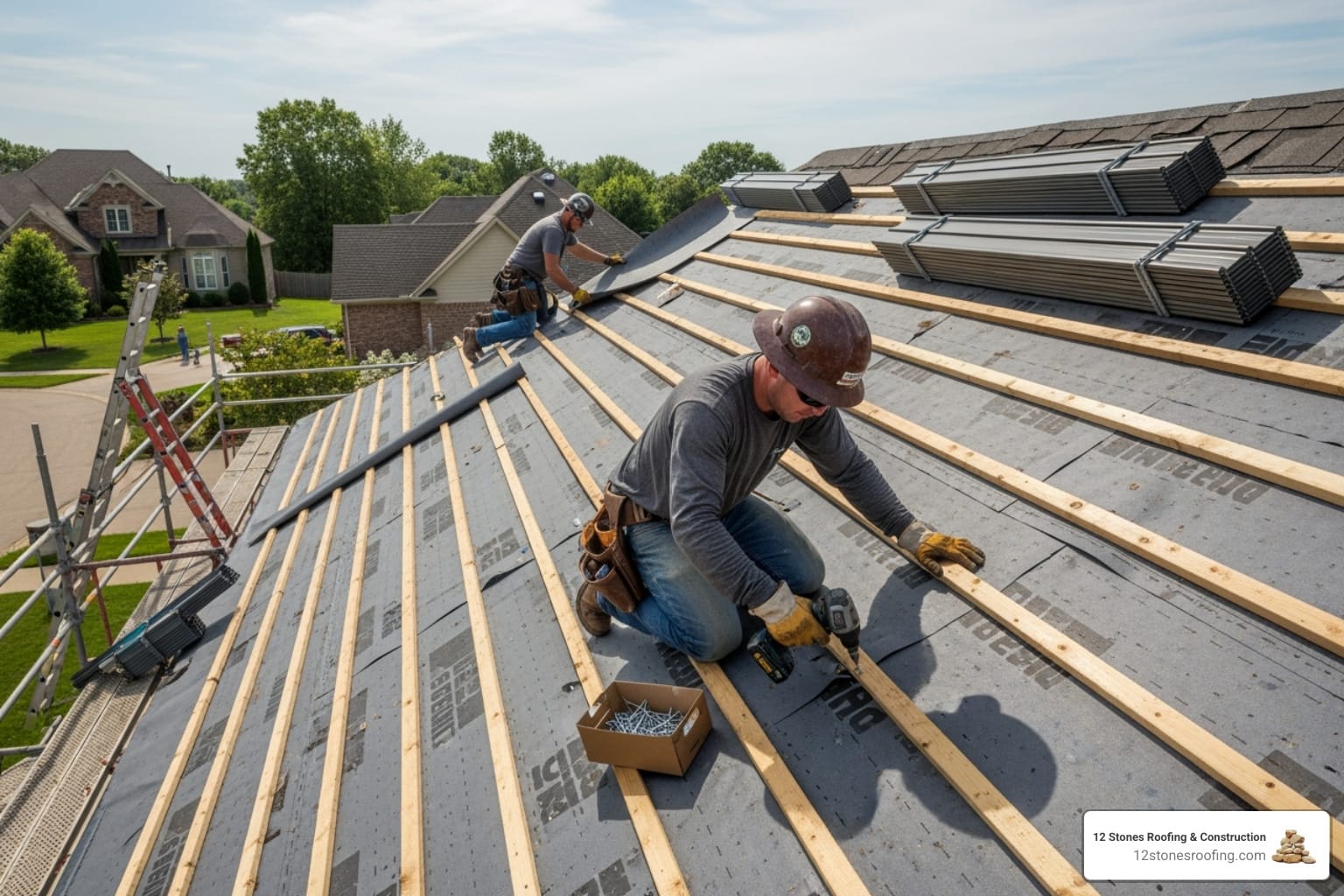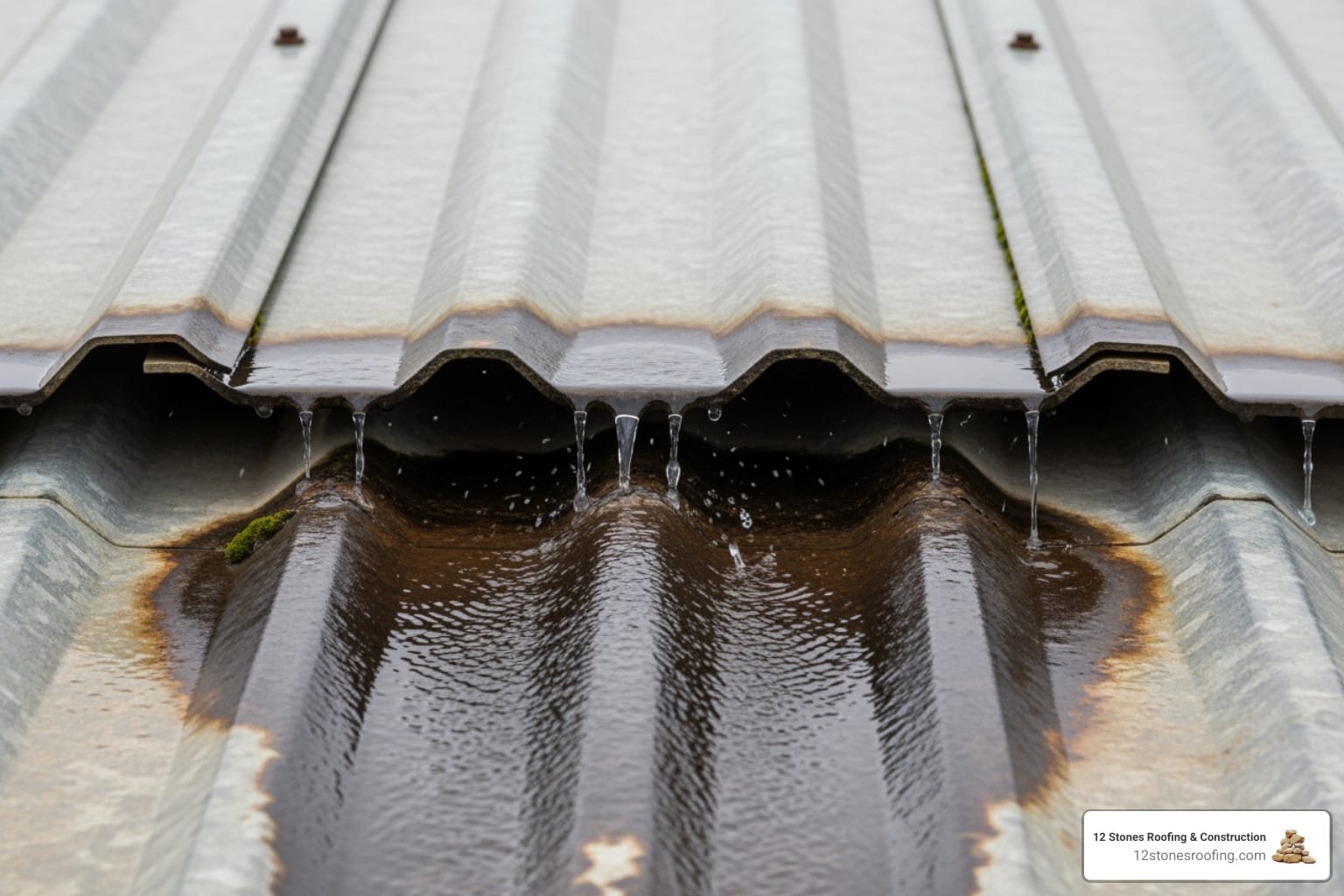Why Every Second Counts When Your Roof Fails
Emergency roofing services provide an immediate response when your roof suffers sudden damage from storms, leaks, or structural failure. When disaster strikes, you need help fast—and a clear plan of action.
If you need emergency roofing help right now:
- Call immediately: Reach professionals offering 24/7 response at 832-278-0210.
- Prioritize safety: Never climb on a damaged roof. Evacuate if you suspect structural failure.
- Contain water: Use buckets to catch active leaks and move valuables to a dry area.
- Document everything: Take photos and videos of all damage for your insurance claim.
There is no convenient time for a roof to fail. An unexpected leak can ruin your day, and the consequences escalate quickly. Water damage repair costs can double for every 24 hours a leak goes unaddressed.
Storm damage accounts for over 50% of all emergency roof repair calls, with high winds, hail, and fallen debris being the most common culprits. Whether you’re dealing with a few missing shingles or water pouring into your attic, an immediate response is critical to prevent secondary damage like mold, structural rot, and ruined interiors. The average cost of an emergency patch ranges from $300 to $1,000, but acting quickly can save you up to 50% on total repair costs by preventing further damage.
I’m Jason Roberts, Owner of 12 Stones Roofing & Construction. With over a decade of hands-on experience in the Gulf Coast region, I’ve personally overseen countless emergency roofing projects for local homes and businesses. My team and I are committed to delivering rapid, reliable solutions when you need them most, backed by top manufacturer certifications and an A+ BBB rating.
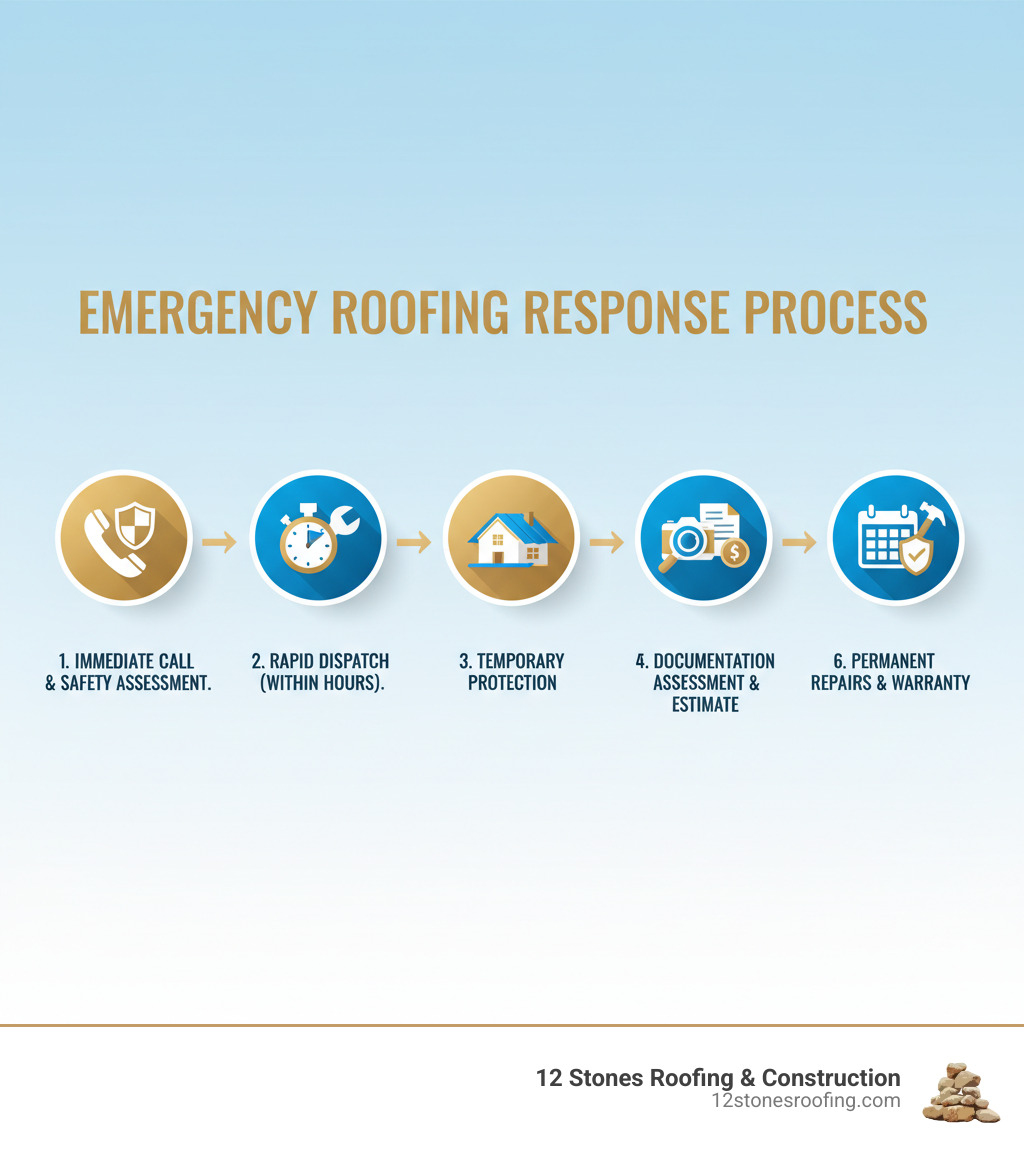
This guide will cover what qualifies as a roofing emergency, the immediate steps to protect your property, how our services work, what to look for in a contractor, and how to prevent future crises.
What Is a Roofing Emergency? 7 Signs You Need Help Immediately
Not every roof issue is an emergency, but knowing the difference can save you thousands. A roofing emergency is any situation where your roof’s integrity is compromised, creating an immediate threat to your property and the people inside. While storm damage is the cause over 50% of the time, the signs can vary.
Here are 7 signs that qualify as a genuine roofing emergency:
- Major Leaks: Water actively pouring into your home, soaking ceilings and walls. This indicates a significant failure of your roof’s protective barrier.
- Structural Damage: A visibly sagging roof deck, cracked rafters in the attic, or a partially collapsed section. These are signs of imminent failure and pose a serious safety risk.
- Fallen Trees or Large Limbs: The impact from a fallen tree can cause unseen structural damage beyond the obvious puncture.
- Fire Damage: Even after a fire is extinguished, the heat can weaken roofing materials, leaving them vulnerable to collapse or leaks.
- Punctures: Any hole from falling debris or severe hail is a direct entry point for water and requires immediate attention.
- Significant Shingle Loss: While a few missing shingles can wait, an entire section blown off exposes the underlayment and constitutes an emergency.
- Non-Obvious Warnings: Widespread granule loss in your gutters, a noticeable sag in the roofline, or large water stains on interior ceilings all point to serious underlying problems.
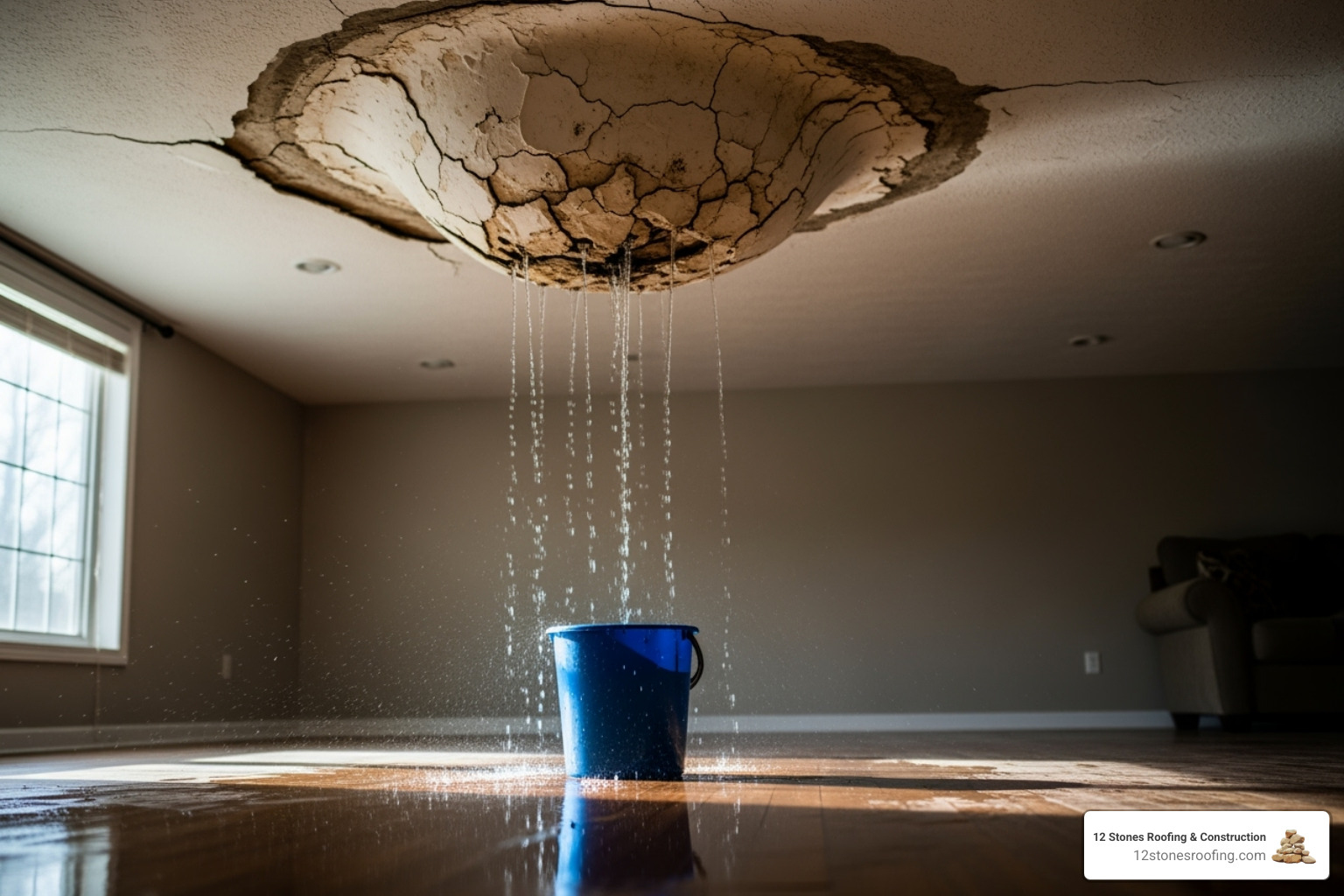
When a Small Leak Becomes a Big Problem
A common mistake is ignoring a small drip or water stain. Small leaks are emergencies in slow motion. Water often travels along rafters and soaks insulation, causing hidden damage. This moisture creates a perfect breeding ground for mold, which can appear within 24-48 hours and lead to costly remediation and health issues. Furthermore, water near wiring or light fixtures creates a serious electrical hazard. That “small” leak can quickly damage drywall, ceilings, and flooring, turning a minor issue into a major expense. Get any leak inspected immediately; for more details, see our guide to understanding roof leak repairs in Houston.
Damage That Compromises Structural Integrity
Some emergencies pose an immediate threat to your home’s stability and require an urgent professional assessment.
- A sagging roof deck indicates that the underlying sheathing or framing is failing, often due to water weight or rot.
- Cracked rafters or trusses in your attic are a major red flag. These beams support your entire roof, and if they are compromised, a collapse could be imminent.
- Wind uplift damage, common in the Gulf Coast, occurs when high winds create pressure that lifts entire sections of the roof, weakening its structural connections.
Any of these issues means your home’s primary defense is failing. For business owners, the stakes are even higher, affecting operations and safety. Learn more in our post on commercial roofing emergencies in Pasadena.
Your Immediate Action Plan: What to Do Before Professionals Arrive
When your roof is damaged, your first actions can save you thousands in secondary damages. Water damage costs can double for every day a leak is left unaddressed. Staying calm and following a clear plan makes all the difference.
Your safety is the absolute first priority. If you suspect a structural collapse, gas leak, or electrical hazard, evacuate immediately and call 911. Once you are safe, follow these steps:
- Stay Off the Roof: A damaged roof is unstable and extremely dangerous. Leave all inspections and repairs to trained professionals with the proper safety equipment.
- Contain Water: Place buckets or towels under active leaks. Use plastic sheeting to channel water from a larger area into a single collection point.
- Protect Your Belongings: Move furniture, electronics, and other valuables away from the affected area. Every item you save is one less you have to replace.
- Document Everything: Take clear photos and videos of the damage, both inside and out (from a safe distance on the ground). This documentation is crucial for your insurance claim.
- Contact Professionals: Call a 24/7 emergency roofer immediately. Our team is standing by at 832-278-0210 because emergencies don’t wait for business hours.
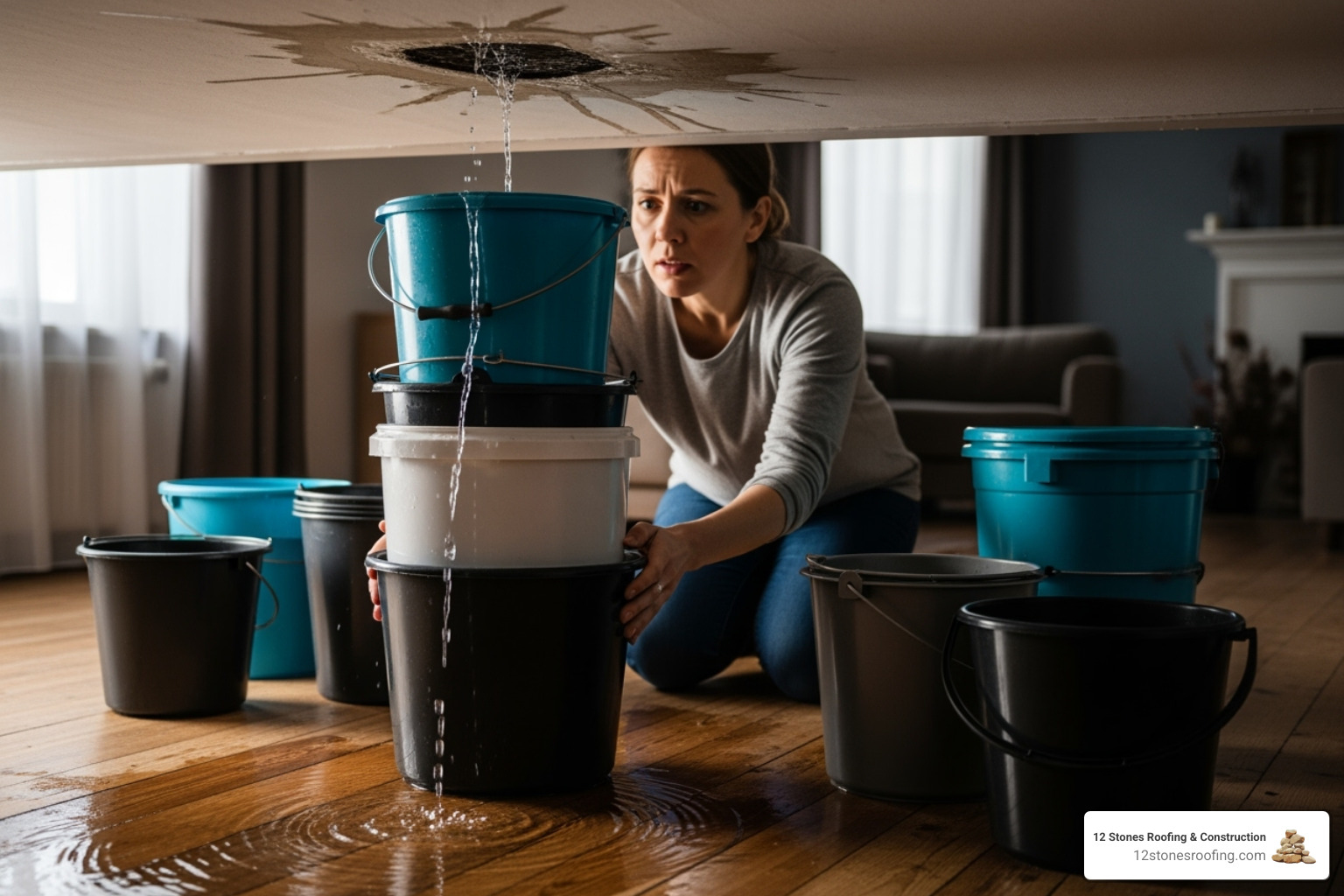
Safely Containing Interior Water Damage
While waiting for our emergency roofing services team, your goal is to limit the spread of water. Start with buckets and towels for drips. For larger leaks, use heavy-duty plastic sheeting taped to the ceiling to funnel water into a container. If a leak is near any electrical outlets or fixtures, turn off the power to that circuit at the breaker box to prevent a fire or electrocution hazard. These are temporary measures to buy you time. Professional tarping provides a more robust, weather-resistant solution that can protect your home until permanent repairs are made.
Documenting Damage for Insurance Claims
Proper documentation is key to a smooth insurance claim. Your smartphone is your most valuable tool here.
- Take numerous photos and videos from various angles. Capture wide shots of the roof damage (from the ground) and close-ups of punctures or missing shingles. Document all interior water damage, including stained ceilings, wet floors, and affected belongings.
- Keep a written log of when the damage occurred, the steps you took to mitigate it, and who you contacted.
- Save all receipts for emergency supplies like tarps and buckets, as your policy may cover these costs.
Many reputable emergency roofers, including our team, have extensive experience with the claims process. We can assist with documentation, provide detailed estimates, and communicate directly with your insurance adjuster to ensure the process is as stress-free as possible.
How Emergency Roofing Services Work: From Rapid Response to Repair
Emergency roofing services operate on a timeline of minutes and hours, not days. The entire focus is on one critical objective: securing your property as quickly as possible to prevent further damage from the elements. The clock starts ticking the moment you call.
Our teams are available 24/7 because roofs don’t fail on a 9-to-5 schedule. Whether it’s 2 PM or 2 AM, our dispatchers are ready to take your call at 832-278-0210. We mobilize a crew within minutes, planning the fastest route to your property to stop the crisis in its tracks. Our rapid-response teams are positioned throughout the Pasadena area to minimize arrival times, often reaching you within hours.
The approach for residential and commercial properties shares the same urgency but differs in scale. Residential response focuses on protecting your home and family, while commercial response addresses larger, more complex systems with the added pressure of minimizing business disruption.
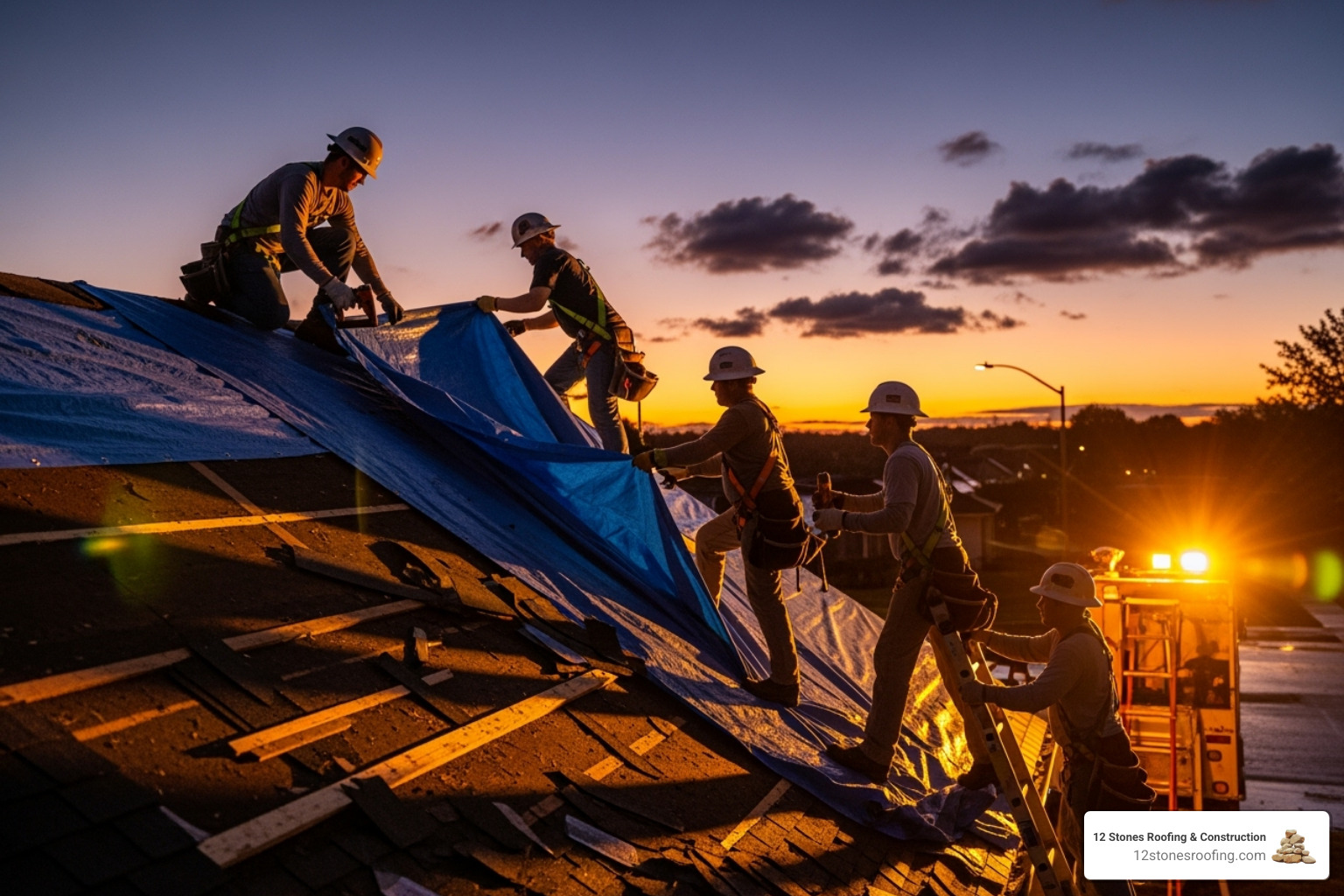
The Difference Between Emergency and Permanent Roof Repair
Think of an emergency repair as a tourniquet—it stops the immediate bleeding. A permanent repair is the surgery that restores your roof to full health.
- Emergency Repairs: The goal is to stop water intrusion and stabilize the structure immediately. This involves applying temporary solutions like heavy-duty tarps, sealants, or plywood patches. These repairs are done quickly, often in adverse weather, to protect your property. They buy you time until a permanent solution is feasible.
- Permanent Repairs: The goal is to fully restore the roof. This requires carefully matched materials, adherence to building codes, and precise installation under optimal weather conditions. This work is designed for longevity and is backed by comprehensive workmanship and manufacturer warranties.
In short, emergency work prioritizes speed and immediate protection, while permanent work prioritizes quality, durability, and aesthetics.
What to Expect from an Emergency Roofing Services Provider
When you call us during a crisis, here’s what you can expect:
- Immediate Phone Response: A live person will answer your call, assess the urgency of your situation, and provide an estimated arrival time.
- Prepared Crew Arrival: Our experienced roofers will arrive in a fully equipped truck with tarps, patching materials, and safety gear.
- On-Site Assessment: The team will conduct a safety check, identify the source of the problem, and determine the most effective temporary solution.
- Temporary Protection: We will secure your roof, most often by installing a heavy-duty, weather-resistant tarp. This isn’t just throwing a sheet over a hole; it’s a secure installation designed to channel water away from the damaged area.
- Detailed Quote for Permanent Repair: Once the immediate threat is contained, we provide a comprehensive quote with photos and line-item pricing for the permanent fix.
- Follow-Up and Scheduling: We work with you to schedule the permanent repairs at your convenience, ensuring constant communication throughout the entire process.
Finding a Trustworthy Contractor for Emergency Roofing Services
In a crisis, it’s tempting to hire the first roofer who answers the phone, but choosing the right contractor is critical to avoid scams and shoddy work. While approximately 70% of homeowners prioritize 24/7 availability for emergency roofing services, verifying credentials is just as important.
Storm chasers prey on desperate homeowners after severe weather. Taking a few minutes to vet a contractor can save you thousands. Here’s what to look for:
- 24/7 Response and Local Reputation: A true emergency service is always available. Prioritize established local businesses with a physical address and positive online reviews. They are invested in the community and accountable for their work.
- Licensing and Insurance: This is non-negotiable. A legitimate contractor will readily provide proof of being fully licensed, bonded, and insured. This protects you from liability. You can often verify a contractor’s license with state boards like this one.
- Experience with Storm Damage: Look for a contractor with proven experience handling the specific types of storm damage common in Texas, from hail to high winds. They will understand local building codes and have experience with insurance claims.
- Transparent Pricing: A reputable company provides clear, itemized quotes for both temporary and permanent repairs without hidden fees or high-pressure sales tactics.
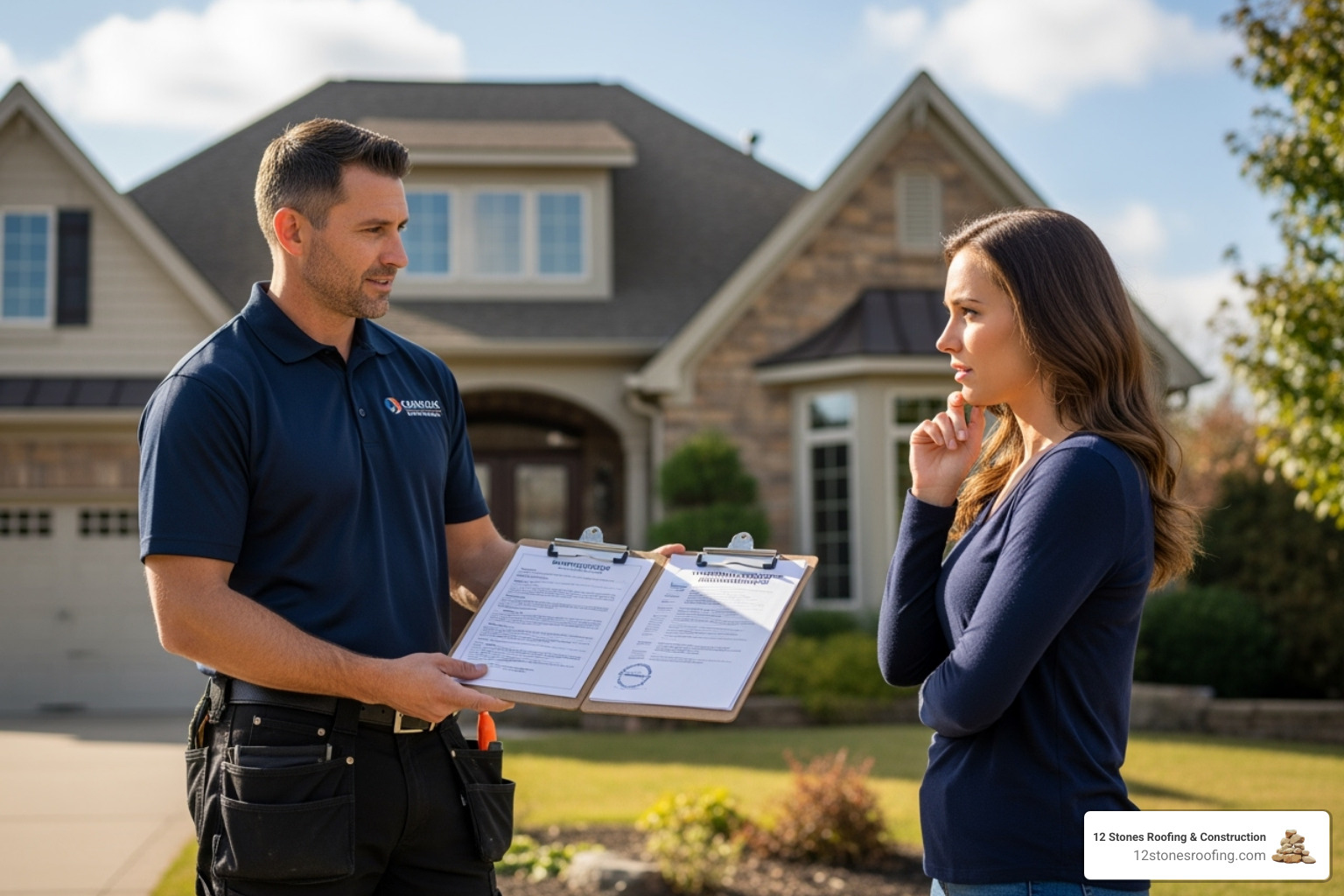
Key Questions to Ask a Potential Emergency Roofer
Before hiring, ask these critical questions to perform your due diligence:
- What is your typical response time for emergency calls? You need a firm commitment, as a rapid response can prevent thousands in additional damage.
- What is the cost for an emergency call-out? Understand any upfront fees. Some companies apply this cost toward the repair if you hire them.
- Do you have experience with my specific roof type? A roofer specializing in asphalt shingles may not be the best choice for a metal or flat roof.
- Can you help with my insurance claim? A contractor experienced with insurance paperwork can be an invaluable advocate.
- What warranty do you offer on emergency and permanent repairs? Get all warranty details in writing. Verbal promises are not enough.
Finding qualified roofers in our area is essential for fast, reliable service. Our team at 12 Stones Roofing & Construction provides prompt, professional emergency roofing services backed by years of local experience. You can learn more about our commitment on our page to find qualified roofers in the Pasadena area. When you need help fast, call us at 832-278-0210—we’re here 24/7.
Proactive Measures: Preventing Future Roof Emergencies
The best way to handle a roofing emergency is to prevent it. While we can’t control Texas weather, regular maintenance and proactive inspections can identify vulnerabilities before a storm turns them into a catastrophe. Acting quickly on a roof leak can save up to 50% on potential repair costs compared to delaying action.
Here are the most effective preventative measures:
- Schedule Regular Inspections: A professional should inspect your roof at least twice a year (spring and fall) and after any severe weather event. This catches minor issues like loose shingles or cracked flashing before they become major leaks.
- Keep Gutters Clean: Clogged gutters cause water to back up under the roof edge, leading to wood rot and leaks. Clear them of leaves and debris, especially in the fall.
- Trim Overhanging Trees: Branches can scrape shingles or fall during a storm, causing significant damage. Keep them trimmed back from your roofline.
- Address Aging Materials: If your shingles are curling, buckling, or have widespread granule loss, they are at the end of their lifespan. Replacing them proactively is far cheaper than dealing with a failure during a storm.
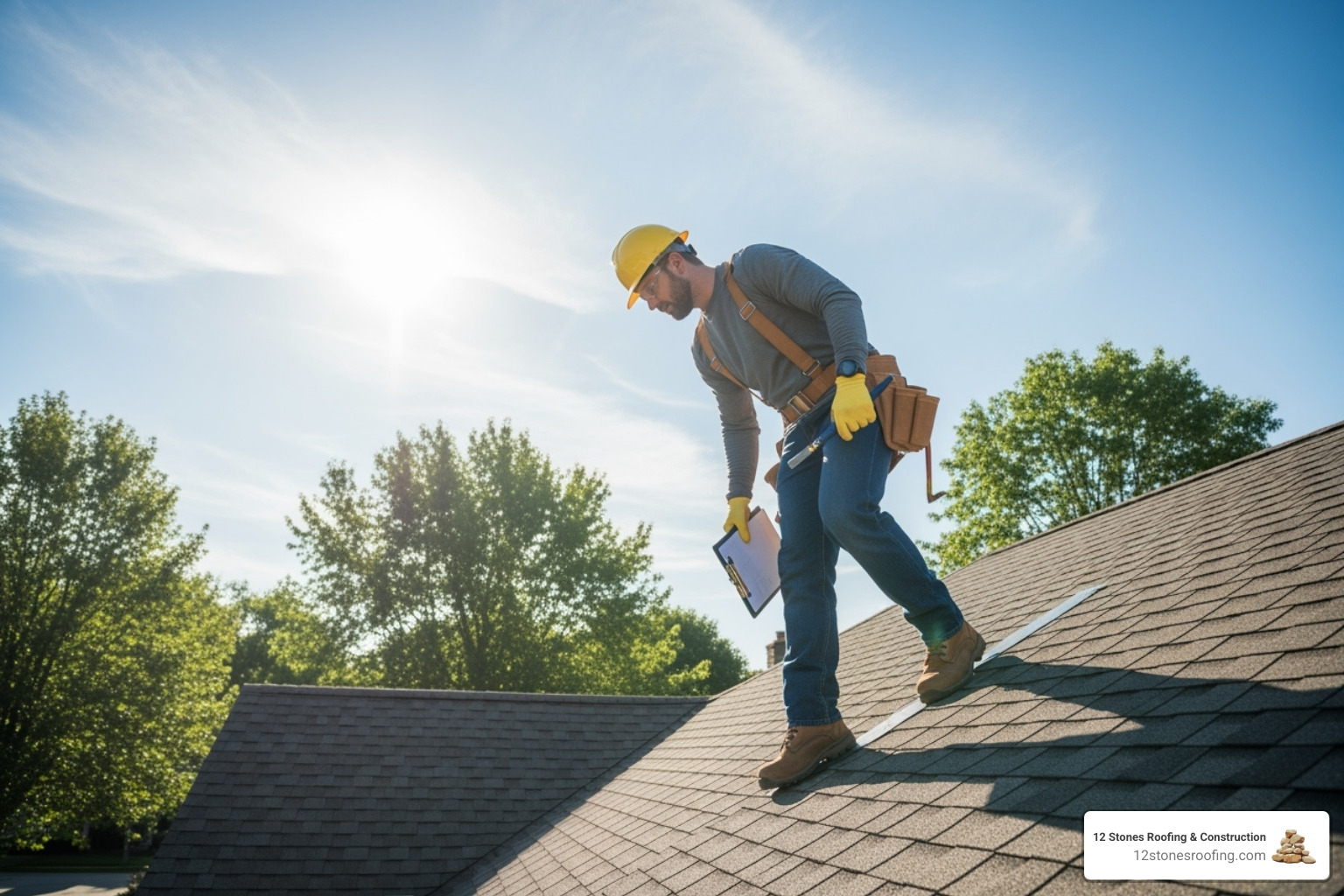
The Long-Term Costs of Neglecting Your Roof
Skipping routine maintenance is a costly gamble. A small, inexpensive fix can quickly escalate into a five-figure problem. Here’s what you risk:
- Interior Water Damage: Beyond a stained ceiling, water can destroy drywall, insulation, flooring, and electrical systems.
- Mold Growth: Hidden moisture from a persistent leak creates the perfect environment for mold, which requires expensive, specialized remediation and poses health risks.
- Structural Rot: Long-term water exposure rots the wooden sheathing, rafters, and trusses of your roof. Repairing this structural damage is complex and extremely expensive.
- Premature Roof Replacement: Neglect shortens your roof’s lifespan, forcing you to pay for a full replacement years earlier than expected.
- Voided Warranties: Many manufacturer warranties require proof of regular maintenance. Neglecting your roof could leave you holding the entire bill for a major failure.
The small investment in routine maintenance is insignificant compared to the financial and emotional cost of an emergency. Prevention is always the most affordable strategy.
When Disaster Strikes, Trust the Experts to Secure Your Home
A roofing emergency is a stressful event, but knowing the right steps can turn a potential disaster into a manageable challenge. The most important takeaway is to act fast. Water damage costs can double for every day a leak is left unaddressed, quickly spiraling into thousands of dollars in structural repairs and ruined belongings.
When you see signs of roof damage—from an active leak to missing shingles after a storm—don’t wait. It will get worse.
Choose wisely. In the chaos of an emergency, take a moment to verify a contractor’s credentials. Look for a licensed, insured, and reputable local company with proven experience in storm damage and emergency roofing services. Ask about their response time, insurance claim assistance, and warranties.
Invest in preventative maintenance. While we can’t stop a storm, regular inspections and upkeep can significantly reduce your roof’s vulnerability. The cost of maintenance is a fraction of the cost of an emergency repair.
For homeowners in Pasadena and the surrounding Texas communities, having a reliable local team on standby is essential. At 12 Stones Roofing & Construction, we’ve built our reputation on being the team homeowners trust during their most stressful moments. Our rapid response, transparent communication, and commitment to quality provide the peace of mind you deserve when your home’s protection is on the line.
We are available 24/7 because emergencies don’t wait. Our experienced crews are positioned to respond within hours, handling everything from emergency tarping to permanent repairs and working directly with your insurance company.
Don’t let a roofing emergency turn into a nightmare. If you’re facing sudden roof damage, water intrusion, or structural concerns, reach out immediately. Every minute counts, and our team is standing by to secure your home and restore your peace of mind. Visit our emergency roofing services page for immediate assistance.



